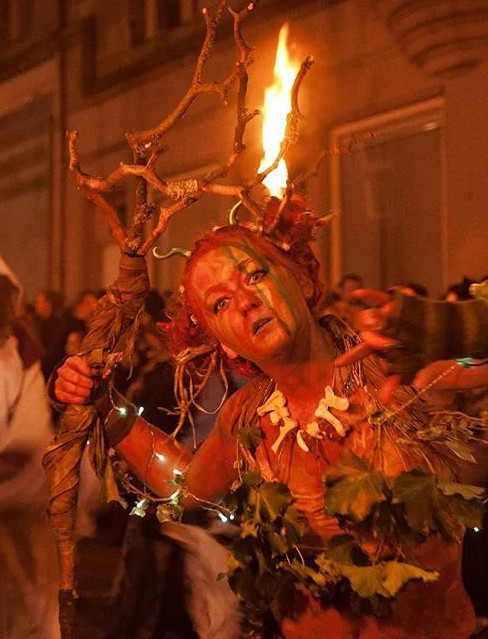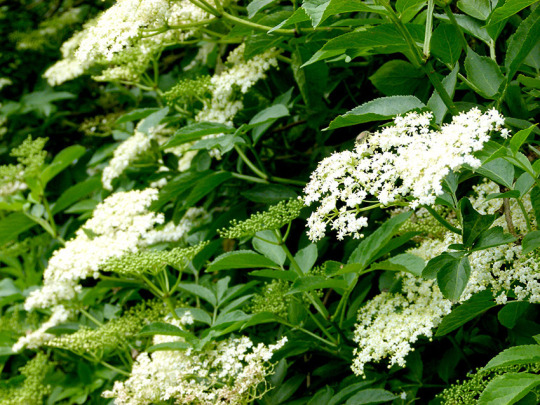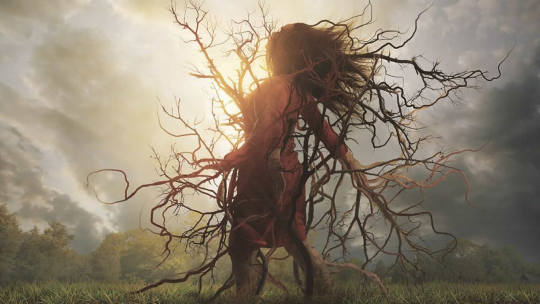#hyldemoer
Explore tagged Tumblr posts
Photo

[Photo above: Samhain, courtesy of Beltane Fire Society]
Legends and myths about trees
Legendary tree deities (22)
Hyldemoer – 'the Elder Mother’, the guardian of the elder trees
“If you stand beneath an elder tree on midsummer eve you will see the King of the faeries and his entourage but be careful that you do not get swept away to faerieland.
The tree and the wood is greatly prized by the fae folk, so it must not be used to make mundane household objects, especially not a cradle or the baby will be pinched black and blue.
Do burn the wood or bring it into the house as this is very unlucky and will bring the devil in.
The Elder Mother guards the tree and although she is usually kind she can become dangerous, if her trees are harmed so you must always ask permission before cutting an elder tree.
To cut elder wood you must say, three times, ‘Elder Mother, please give me some wood, and I’ll give you some of mine when I grow into a tree (Ourd gal, give me some of thy wood, an oi will give some of moine, when oi grows inter a tree)’.”
Faeries and Folklore from the British Isles
The Elder Mother is thought to be the guardian of the elder trees, and it was said, until recent times in various parts of England and Scandinavia that to take wood from the elder tree one would have to ask the Elder Mother first, or else ill luck would befall the woodsman. The spirit is said to haunt or torment people who build from elder wood unless they ask permission first.
In Denmark, the Hyldemoer (“Elder-mother”) or Hyldequinde (“Elder-woman”) is a spirit like a wood-nymph or dryad that lives in the elder tree.
Other similar and related beliefs have been handed down in various cultures.
In Denmark, an elder twig put in the mouth was traditionally thought to drive out evil spirits and thus could cure toothache. Also in Denmark, on Midsummer's Eve, if you were to stand under an elder, you could see the Elf-king and his host. A similar tradition existed in Scotland where it was said to happen on All Hallows or Samhain.
In England, it was thought that the elder tree could never be hit by lightning and that carrying the twigs of an elder could protect their bearer from rheumatism. Farmers used to protect their animals from evil by placing a cross made from elder on their cow-sheds and barns.
In some Slavic countries, such as Russia, it is thought that the tree had the power to ward off evil. In Sicily, it was claimed to have the power to ward off snakes, and so on.
Every summer, our neighbourhood had an elder hedge with divine, full blossoms, but it was completely cut down to develop a residential site. These days, they spray the stumps with powerful chemicals to prevent regrowth.

木にまつわる伝説・神話
伝説の樹木の神々 (22)
ヒルデモア-「エルダー・マザー」、ニワトコ (エルダー) の木の守り神
“真夏の夜、ニワトコの木の下に立つと、妖精の王とその一行を見ることができる。でも、妖精の国に流されないように気をつけて。
この木と木材は、妖精たちにとても珍重されている。だから、ありふれた家庭用品を作るのに使って��いけない、特にゆりかごは厳禁だ。さもないと、赤ん坊は青黒く痣が付くまでつまんで痛めつけられる。薪を燃やしたり、家の中に持ち込んだりしてはいけない。これは非常に不吉で、悪魔がやってくるからだ。
エルダー・マザーは木を守っている。彼女は普段は優しいが、ニワトコの木に危害を加えると危険な存在になる。だから、ニワトコの木を切る前には、必ず許可を得ること。
『ニワトコのお母さま、私にあなたの薪をちょうだい。私が木に成長したら、私の薪も差し上げます』と、3回唱えなければならない。”
ブリテン諸島の妖精と民間伝承より
エルダー・マザーはニワトコ(エルダー)の木の守り神であると考えられており、イギリスやスカンジナビアの各地では最近まで、ニワトコの木から木材を取るにはまずエルダー・マザーに許可を得なければならず、さもなければ木こりに不運が降りかかると言われていた。その精霊は、まず許可を得なければ、ニワトコの木で建物を建てた人に取り憑いたり、苦しめたりすると言われている。
デンマークでは、ヒルデモア(「ニワトコの母」)またはヒルデキンデ(「ニワトコの女」)は、ニワトコ(エルダー)の木に住む木の妖精やドライアドのような精霊である。
このほかにも、さまざまな文化圏で似たような信仰が受け継がれている:
デンマークでは伝統的に、ニワトコの小枝を口に入れると悪霊が追い出され、歯痛が治ると考えられてきた。またデンマークでは、夏至祭の夜にニワトコの下に立つと、エルフの王とその群れが見えるとされていた。スコットランドにも同様の伝統があり、万聖節(All Hallows)またはサウィン祭(Samhain)に起こると言われていた。
英国では、ニワトコの木は雷に打たれることがなく、ニワトコの小枝を持っているとリューマチから身を守れると考えられていた。農家では、ニワトコで作った十字架を牛小屋や納屋に置くことで、家畜を悪魔から守っていた。
ロシアなどのスラブ諸国では、この木には魔除けの力があると考えられていた。シチリアでは、蛇を追い払う力があるとされていたなどなど…。
毎年夏になると、近所にニワトコの生け垣があり、神々しいほどの満開の花を咲かせていたが、宅地開発のために完全に切り倒されてしまった。最近では、再生を防止するため、切り株に強力な化学薬品を撒くらしい。
#trees#tree legend#tree myth#elder mother#hyldemoer#elder wood#elder trees#legend#folklore#mythology#all hallows#samhain#fairy#fairy tree#nature#art
100 notes
·
View notes
Text
Hyldemoer: el espíritu guardián de los árboles

Hyldemoer: el espíritu guardián de los árboles
La mitología siempre ha sido relacionada con los dioses y los espíritus guardianes de la naturaleza. Así es como los nórdicos tienen la historia de Hyldemoer, el guardián de los árboles.
LEE MÁS
0 notes
Text
THE ELDER-TREE MOTHER
A translation of Hans Christian Andersen’s “hyldemoer”
Once there was a little boy who went out and got his feet wet and caught a cold. Nobody could understand how it had happened because the weather was very dry.
His mother undressed him, put him to bed, and had the tea urn brought in to make him a good cup of elder tea, for that keeps one warm.
At the same time there came in the door the funny…
View On WordPress
0 notes